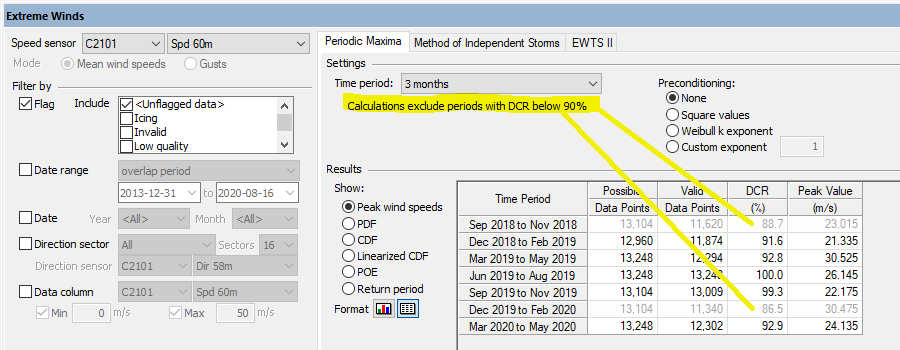
| Periodic Maxima Algorithm |  |
The Periodic Maxima algorithm takes the maximum wind speed recorded in each time period (e.g. year or month), fits a distribution to those maxima, and then uses that distribution to calculate the 50-year extreme wind speed. It is one of the extreme wind algorithms that you can use in Windographer.
On the Periodic Maxima tab of the Extreme Wind window, you can set the time period to as long as one year or as short as one month. Windographer finds the maximum wind speed in each time period, fits a Gumbel distribution to those maxima using the Harris 1996 algorithm, and calculates the wind speed that corresponds to an annual probability of 0.02 (once in 50 years) for that best-fit Gumbel distribution. That wind speed is the 50-year return value.
Tip: The Harris 1996 algorithm can handle a maximum of 120 data points, so for very long datasets it might fail to perform the Gumbel fit if you choose too short a time period.
The algorithm will exclude any time period that fails to meet the minimum data coverage settings you have specified in the Options window. The Periodic Maxima tab displays the minimum data coverage rate relevant to the time period you have chosen. In the screenshot below that minimum DCR is 90%, but that might change if you chose a different time period or modified your minimum DCR settings in the Options window. In the table of peak wind speeds, time periods excluded because of low data coverage appear in muted colors:

With the Preconditioning radio buttons you can choose to apply an exponent to the wind speed values before performing the Gumbel curve fit. Preconditioning can often improve the convergence of the curve fit and therefore improve the estimate of the 50-year extreme wind speed.
See also
Minimum data coverage settings